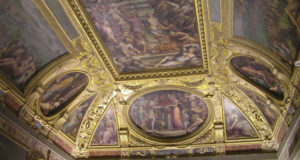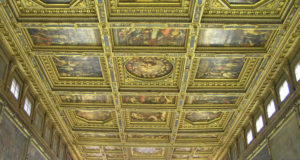Among the statues present today in the Loggia della Signoria or dei Lanzi, the Perseus by Benvenuto Cellini is probably the most important and extraordinary work from an artistic and technical point of view. This statue is considered a masterpiece of Italian Mannerist sculpture and one of the most famous statues in Piazza della Signoria in Florence. The famous bronze ...
Read More »Loggia della Signoria (Loggia dei Lanzi): an open-air museum
The Loggia della Signoria, also called Loggia dei Lanzi because of the guard of German mercenaries (lansquenets) who stood here in the sixteenth century, was built in the fourteenth century thanks to the work of Simone di Francesco Talenti, Lorenzo di Filippo and Benci di Cione. This structure was originally used to host indoor public popular assemblies and official ceremonies ...
Read More »Piazza della Signoria: the center of political power
Piazza della Signoria is an open-air museum which, at every step, offers glimpses and panoramas of particular beauty. In this square there are testimonies of a thriving past and architectural treasures of enormous value. Which, then, are found a bit all over Florence. Famous in the world since ancient times, and probably the most important cultural center in Italy. Cradle ...
Read More »Hall of the Lilies in Palazzo Vecchio, Florence
The Hall of the Lilies (Sala dei Gigli) takes its name from the floreal decorations on its ceiling and walls, it’s the only one Hall of Palazzo Vecchio that still today conserve the 15th century aspect. The Hall was obtained in 1472 from the division in two rooms of the Sala Grande carried out from Benedetto and Giuliano da Maiano, ...
Read More »Chapel of the Priors in Palazzo Vecchio, Florence
The Cappella dei Priori (Chapel of the Priors) also called Cappella della Signoria was built between 1511 and 1514 by Baccio d’Agnolo and its decoration was entrusted to Ridolfo del Ghirlandaio (Ridolfo Bigordi said il Ghirlandaio), son of the famous Domenico Ghirlandaio. The chapel is dedicated to St. Bernard and consists of two rooms with vaulted ceilings: the altar area ...
Read More »Apartments of Eleonora in Palazzo Vecchio, Florence
After the visit of the Apartment of the Elements cross the gallery from which it dominates the Salone dei Cinquecento and enter the Apartments of Eleanora. The Apartments of Eleonora is so named because when Cosimo I established his residence in Palazzo Vecchio this wing of the building was reserved to the rooms of his wife Eleonora of Toledo, daughter of the ...
Read More »Apartments of the Elements, Palazzo Vecchio, Florence
The visit of the second floor of the Palazzo Vecchio begins with the so-called Apartments of the Elements. These rooms were the private rooms of Cosimo I. In this section of the building are: the Hall of the Elements, the Hall of Opi, the Hall of Ceres with the Scrittoio di Calliope, the Hall of Jupiter, the Terrace of Juno, ...
Read More »Audience Hall in Palazzo Vecchio, Florence
We now reach the Sala dell’Udienza which was the Chamber of Justice, used for the meetings and hearings of the Signoria. Originally also on this floor there was a large hall, the Great Hall. Its dimensions were similar to those of the underlying Salone dei Duecento. But between 1470 and 1472 the room was divided, by the work of Benedetto ...
Read More »Study of Francesco I de’ Medici in Palazzo Vecchio
At the end of the wall of the Salone dei Cinquecento (the one where the entrance is), there is a small masterpiece of Florentine mannerism, the study of Francesco I (in Italian “Studiolo di Francesco I” also called Tesoretto or Scrittoio del Duca). It is a small side room without windows that was part of the private apartments of Francesco ...
Read More »The Courtyard of Palazzo Vecchio, Florence
The first courtyard of Palazzo Vecchio was built in the first half of the fourteenth century and then modified by Michelozzo in the fifteenth century. This architect replaced the pillars with cylindrical and octagonal columns and then built the loggia. In the second half of the 16th century, the entire building underwent major modification works carried out by Vasari at ...
Read More »Palazzo Vecchio: one of the symbols of Florence
One of the symbols of Florence, Palazzo Vecchio or Palazzo della Signoria was designed by Arnolfo di Cambio around 1299 as the residence of the Priors of the Arts, the palace was completed in 1314. The 94-meter-high tower of Palazzo Vecchio, called the tower of Arnolfo was built in 1310, together with the palace. It was probably supported by an ...
Read More »The Importuno by Michelangelo, Palazzo Vecchio
Florence is a historic city full of legends. Among these there is a singular one concerning Michelangelo Buonnarroti. The great artist author of the David and the Pietà could have made one of his works in a stone of Palazzo Vecchio. But what is most surprising in the legend is the way in which the artist would have created the ...
Read More »Quarters of Pope Leo X in Palazzo Vecchio
Hall of Leo X and the Hall of Clement VII The Quarters of Pope Leo X are on the first floor of the Palazzo Vecchio, these rooms were modernized by Giorgio Vasari in 1555-62. The decorations of the same Vasari and Gino Lorenzi, are dedicated to the most illustrious personages of the Medici family and their businesses. These rooms have been used in ...
Read More »Hall of Geographical Maps in Palazzo Vecchio
At the end of the museum itinerary is the Hall of Geographical Maps (Sala delle Carte Geografiche) or Stanza del Guardaroba. In this room was originally the Medici Wardrobe of Grand Duke Cosimo I. That is, the seat of the institution that preserved, inventoried and moved all the assets of the State and the Sovereign. The room has a beautiful ...
Read More »Salone dei Cinquecento in Palazzo Vecchio, Florence
The Salone dei Cinquecento was built in 1495, during the period of restoration of the Florentine Republic. That is, after the expulsion of Piero de’ Medici in 1494. The work was done by Simone del Pollaiuolo called “il Cronaca” (1457-1508) assisted by Francesco di Domenico and Antonio da Sangallo. The huge hall was built at the behest of Frà Girolamo ...
Read More » Borghi di Toscana Guida ai borghi e ai paesaggi della Toscana
Borghi di Toscana Guida ai borghi e ai paesaggi della Toscana














